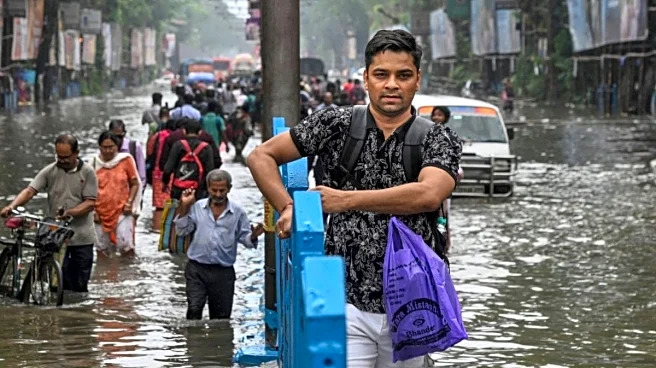After heavy rains and flash floods in the Himalayan states, the monsoon has intensified over eastern India. Kolkata was struck by intense rain early Tuesday—nearly a cloudburst—with 98 mm of rain falling in just one hour. The relentless downpour caused severe waterlogging across the city and led to seven deaths, mostly due to electrocution.
According to the India Meteorological Department (IMD), Kolkata’s Alipore observatory recorded a staggering 251.4 mm of rainfall in 24 hours, causing massive urban flooding in the state’s capital. But the intensity increased, especially after 2.30 am, when nearly 185.6 mm fell in just three hours up to 5.30 am.

It peaked at around 3 am on Tuesday, when the highest hourly rainfall of about 98 mm was observed
till 4:00 am at Alipore (Kolkata). “As it is less than 100 mm, it does not satisfy the cloudburst criteria,” said IMD, which declares a cloudburst when typically, 100 mm of rain falls over a very small area in a very short time, generally an hour.
What led to the downpour?
The southwest monsoon has been active over south Bengal. According to meteorologists, the downpour was triggered by an intense rainy system—a low-pressure system that formed on Monday morning and slowly moved to coastal areas of Gangetic West Bengal and adjoining north Odisha and the northwest Bay of Bengal early on Tuesday. It brought in strong moisture over Kolkata and nearby areas, with clouds reaching heights of 5 to 7 km.
The latest forecast showed that the low-pressure area over the coastal areas of Gangetic West Bengal and adjoining Odisha and the northwest Bay of Bengal continues to persist and is likely to remain over the region for the next 24 hours and weaken by Wednesday. Light to moderate rainfall persists over some areas with orange code warnings, but the overall activity has also decreased gradually. Apart from Alipore, Salt Lake observatory also recorded 230 mm rainfall, 130 mm in Amta (Howrah), and 110 mm in Digha.

Another low-pressure area developing
The MeT has now alerted about another low-pressure area, which is predicted to form over the Bay of Bengal around Thursday and move westwards. It will continue to intensify in the sea and become a depression off the coast of south Odisha and north Andhra Pradesh on September 26. It is very likely to cross the south Odisha and north Andhra Pradesh coast around September 27 and bring heavy rains and gusty winds.
The forecasters have warned of squally weather with winds over 45 km/h expected in the North Bay of Bengal area and along the West Bengal-Odisha coast from September 23 to 27. The sea conditions are expected to be rough, and fishermen have been advised not to venture into the sea till the system passes.
Low-pressure areas are a regular occurrence during the monsoon season and are responsible for some intense spells, but they can also form during other seasons. Meanwhile, the southwest monsoon has already begun to withdraw from the northern parts of the country and is expected to retreat from more parts of Gujarat, Rajasthan, Haryana, Punjab, and some parts of Uttar Pradesh, Himachal Pradesh, Delhi, Jammu and Kashmir by Wednesday. Overall, the monsoon rains over the country are nearly 7% above normal, with only east and north-east India reeling under a deficit of -18%, while the rains have so far been above normal in other geographical subdivisions.







/images/ppid_59c68470-image-175852752651456040.webp)


/images/ppid_a911dc6a-image-175861564569544532.webp)



/images/ppid_a911dc6a-image-1758367029102741.webp)

